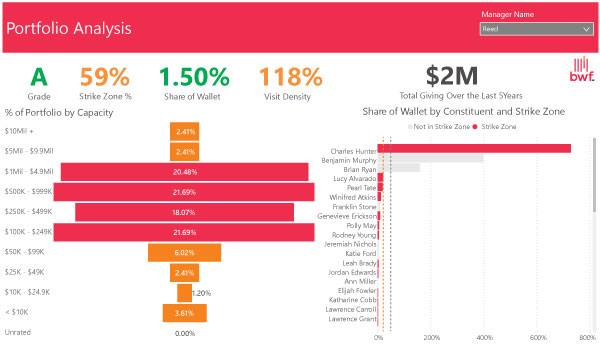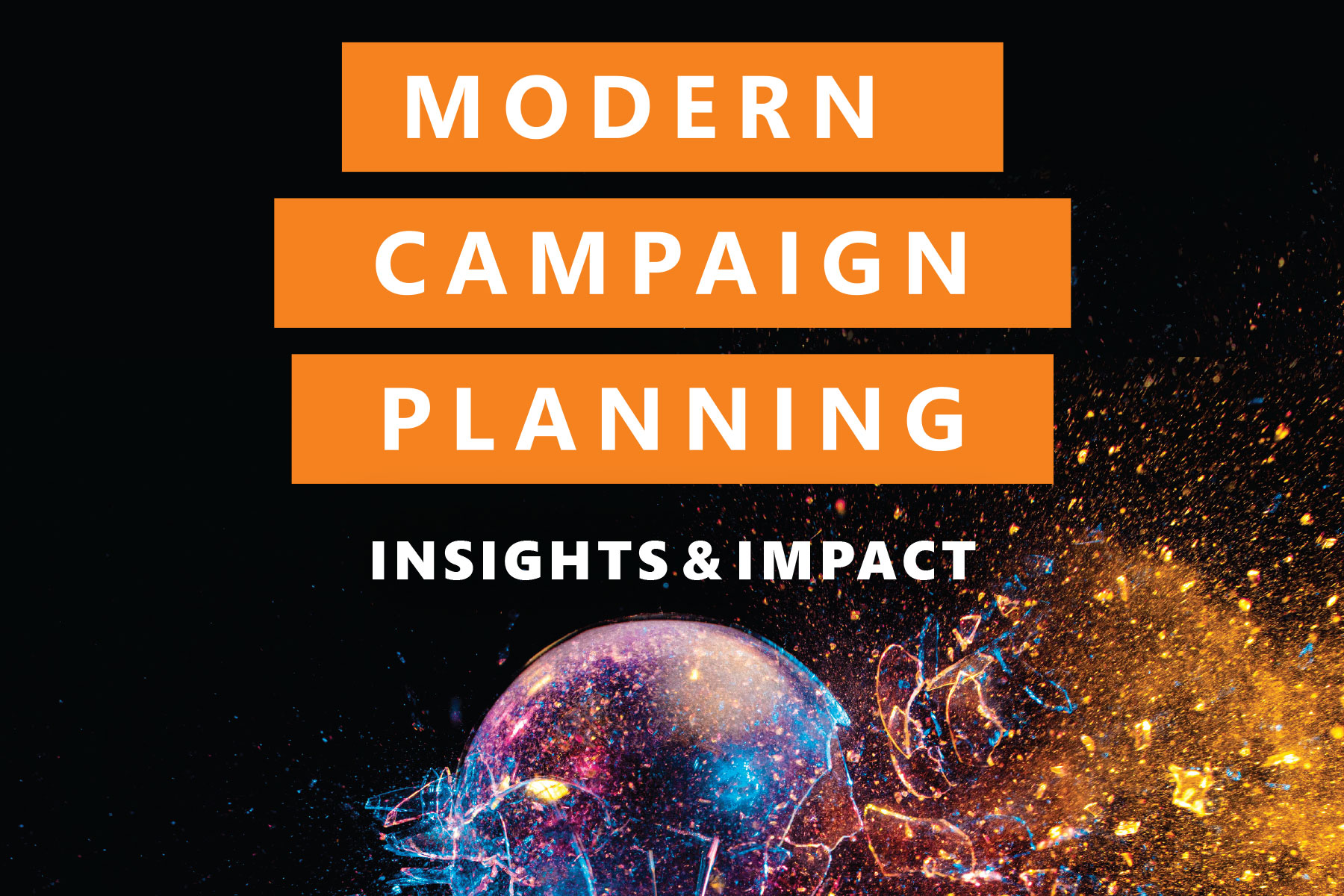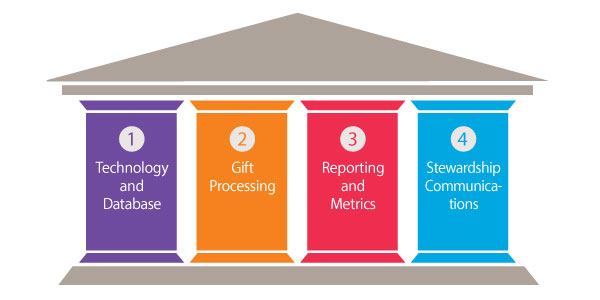Strengthening the Operation:
Organizational Structure and Readiness
Equally important to an organization’s ability to reach increased fundraising goals is operational readiness. After all, even if an organization has an excellent relationship with a potential donor, a misspelled name in the database, a delay in processing a gift, ill-timed outreach, or multiple touchpoints to the same donor can all lead to embarrassing and potentially damaging incidents.
However, these issues can be addressed and solved with well-defined internal procedures.
It’s important to view the organizational structure with a critical eye to the role it will play in a campaign. If the operations department isn’t prepared to support the campaign productively and efficiently, then changes need to be made intentionally and quickly before the campaign is launched.
The operations team should be staffed in proportion to the frontline fundraisers. Staff members should have clearly defined functional roles and job descriptions, the requisite skill sets, and adequate training. The budget must be sufficient to meet current needs while ensuring success in meeting campaign goals. And key areas of the advancement or development program must be able to communicate and work together cohesively and effectively.
Additionally, it’s important that from the onset of planning, the systems and operations team is at the table to think through and then support the fundraising efforts in such matters as how quickly gifts can be processed and distributed, how receipts can be utilized to communicate additional information regarding the campaign, and how much they can help the donor understand what their donation contributes to the overall success of the effort.
Order a complimentary copy today.
Pillars of Operational Readiness
In addition to preparing your data, below are critical areas to consider when determining the organization’s readiness for a campaign.
#1 Technology and Database
Infrastructure is one of an organization’s most valuable assets. But if internal operations are ignored, fundraising efforts will suffer and fall short of goals and expectations. This may result from a lack of resources or appreciation for how technology can support fundraising initiatives. Properly implemented technology should support efforts in managing donor relationships, maximizing frontline talent, and supporting timely fundraising activities. Recognizing that philanthropy requires both frontline fundraiser capacity and organizational infrastructure is critical to achieving success.
The database should support development and campaign needs by providing accurate, complete, and timely data and information. If the current development database isn’t adequate to meet anticipated growth, or current systems and databases aren’t interacting effectively, then upgrades or changes may be necessary before the campaign gets underway in earnest. To execute large-scale communications and solicitations, as well as more customized and personalized outreach, donor information must be of good quality.
Over the last several years, the planning for and implementation of technology ecosystems, including fundraising CRMs, has become more complex. Development platforms such as Salesforce, Slate, and Microsoft Dynamics have provided institutions with more scalable solutions, but they also require more complex skillsets and planning to administer well.
If an organization is thinking about the next generation of fundraising technology, the key to success is starting early, conducting a comprehensive assessment of the current situation, and using resources thoughtfully to plan for the future well in advance of a potential campaign.
#2 Gift Processing
Efficient acknowledgement of donations is mandated by IRS regulations. A campaign is an ideal time to identify novel ways to steward donors as they make payments or are paying off significant pledges. Before launching a campaign, ensure that gift acceptance, counting, and crediting policies have been reviewed and revised for the campaign to guide how the organization will count complex donations such as planned giving bequests and in-kind donations.
If there are any existing delays in processing transactions effectively and/or sending receipts and acknowledgements in a timely manner, those must be addressed, as should any anticipated inability to handle spikes in processing that might occur during campaign pushes or during difficult staffing periods such as holiday breaks. To that end, business processes must be well-documented to accommodate staff departures and onboarding during a busy campaign. Any gaps or deficits identified should be addressed well before mounting a campaign. Once a campaign is underway, there will be enough external pressures to demand resources, so being well prepared is key.
#3 Reporting and Metrics
It’s important to identify the campaign’s Key Performance Indicators (KPIs) and the other critical metrics prior to a campaign’s launch to ensure performance can be measured consistently over time. Having a dashboard facilitates reviewing and analyzing these measures so that course corrections can be made. Leaders should have easy access to the dashboards to inform decision making, as should staff to inform their work. For gift officers, not only should their portfolios be balanced and appropriately sized, but they also should be able to easily gauge their success and progress towards performance goals.
#4 Stewardship Communications
When considering the donor life cycle, the ultimate goal for stewarding is to cultivate the next donation.
These communications are often an afterthought for busy and lean staffs. For organizations with a donor relations team or a communications team—or ideally both—strong stewardship communications are critical to any successful campaign ramp-up or ongoing outreach efforts. Effective and strategic stewardship that includes timely, relevant, impactful, and donor-centric communications is vital to further engaging and retaining donors.
Due Diligence
When considering the donor life cycle, the ultimate goal for stewarding is to cultivate the next donation. For most organizations, gift acceptance policies cover general guidelines for what gifts the organization will and will not accept, but few address end-to-end fundraising situations and even fewer organizations translate their policies into specific procedures and training for staff and volunteers. In an ideal world, organizations would not need due diligence policies. Who wants to turn away much needed support or gifts to an organization, much less divert additional hard-earned resources to implement a process to support it? But as fiduciaries of our donors’ resources, we must.
Before writing the policy, consider these factors:
- The process needs to begin by defining which area or areas will be impacted by the due diligence policy and, from there, who should be involved in the discussions.
- Think critically about potential risks that could impact the organization, be they dependency risks (in which the donor, company, or foundation seeks undue influence) or reputational risks (in which engagement with specific people, companies, or foundations might reflect poorly on the organization). Even geographic locations can become problematic if local or state issues run counter to an organization’s mission or constituency.
- Every nonprofit should use their mission as the basis of their decision making, but a mission alone is not Organizations must be able to define which specific categories of support and conditions are unacceptable and which may require additional consideration.
A due diligence policy should detail how leadership expects the organization to address certain issues while providing broad guidance for unforeseen situations and changing times. Staff will be needed to conduct due diligence research, and training will be needed for all involved in any level of the process. Systems must be in place to ensure data protection and to automate and streamline the adopted due diligence process so that expectations can be fulfilled amidst various competing organizational priorities. And a gift acceptance committee and an agile process will also ensure the organization is able to address unique situations.
Data Readiness for Campaign Solicitation
To ensure a campaign is successful, organizations must have accurate, complete, and timely information on donors and prospects. That means having processes and procedures for data throughout the entire campaign planning cycle as well as the constituent life cycle.
Inputting Data: Assess the donor database and associated processes to anticipate potential gaps before adding a large volume of wealth screening results, biographical information, prospecting results, and/or gifts. It’s much easier to make system and process adjustments during the campaign planning phase than while in the midst of a major campaign.
Cleansing Data: Maintain and audit the database regularly with a goal of maintaining high data integrity. The organization should conduct regular data audits and mass cleansing/appending of data, such as National Change of Address. Organizations that are unable to contact their constituents are at a disadvantage.
Reviewing Business Processes: Pre-campaign is the time to review processes in an effort to streamline data processing, reporting, and donor tracking.
Empowering Decision Making Through Data: In addition to improving data exports, optimize systems to receive data inputs from empowered end users, such as contact reports and address updates. Modern, comprehensive fundraising campaigns demand a great deal of data consumption. The organization should be ready for the push by users for additional data.
Stewarding Through Data: Donors are more likely to trust an organization with their dollars if they have faith that the organization is well-organized and will be a good steward of their gifts. Efficient gift processing, timely acknowledgement, and effective follow-up are important factors in building this trust.
The above data-related items are key components of a comprehensive data governance program, which is important to campaign planning. After all, the purpose of data governance is to ensure the organization is acting cohesively to manage its data so that it best serves the donors in terms of accuracy, integrity, voice, and communications preferences. If your organization lacks a formal data governance initiative, then the beginning of campaign planning is an excellent time to get one underway.
Data-Driven Decision Making
Data points abound that can be used to predict giving behavior, identify donor life cycles, examine campaign performance, and customize outreach approaches and relationship management.
There has never been a more important time for data within the world of philanthropy. Today’s fundraisers have exponentially more data at their disposal. Data points abound that can be used to predict giving behavior, identify donor life cycles, examine campaign performance, and customize outreach approaches and relationship management. The enthusiasm to capture and leverage data has only increased the value of both data science and business analytics.
Today, the volume of data is well beyond the scale of human capacity to efficiently understand it. Simply put, data is “too big” to eyeball in Excel to find top prospects, forecast what can be raised, or choose the appropriate appeal message to deploy.
To meet this challenge, the fundraising industry is increasingly looking towards machine learning and even artificial intelligence (AI) to leverage data and maximize this essential resource. Machine learning has been impacting fundraising for over a decade, and the promise of AI is a natural innovation. Depending on the organization’s analytics maturity, these technologies may be a valid solution to help reach goals, automate tasks, or improve efficiency.
Leveraging data to support campaign goals is worth the investment of time and resources. When used strategically and productively, data can play a key role in campaign success:
Program Capacity Analysis & Forecasting: Leading into campaigns, the past can be an informative guide for the future. Organizations should study giving over time, the relationship to external benchmarks, rolling rates of change, areas of opportunity, gap areas, and projections for status quo/business-as-usual as well as ramping up or tweaking portfolio optimization, performance management, and staffing. Use data to develop business processes connected with reinforcing strength areas and overcoming shortcomings.
Wealth Screening: Every organization should commit to regular wealth screening as a pre-prospect research filter and primary component for initial pyramid design. Screen comprehensively at the start of a campaign, with batch screening for new constituents (i.e., new alumni, grateful patients, parents, subscribers, etc.) periodically thereafter.
Predictive Modeling: Although wealth screening is an effective filter for capacity, it does not screen for propensity. Predictive modeling, however, can identify prospects most likely to give to a campaign. Also, for many high-performing organizations, predictive modeling is the primary resource for segmenting direct response programs (saving costs by soliciting only those most likely to respond), identifying new potential in the pipeline to cultivate, fine-tuning processes, and measuring the depth of relationships. Predictive models represent a snapshot in time, so monitor, evaluate, and refresh the models on a regular basis with consideration for how they will be stored and accessed in the database. Users should then be trained in how best to access and use the data in their day-to-day fundraising activities.
Data analytics is now mainstream in fundraising. Development programs routinely conduct wealth screenings, manage prospect pool algorithms, and gather gift officer metrics both to identify employee strengths and weaknesses and to encourage behavior that will yield the best outcomes. Data collection is also changing how alumni and parent relations programs can target and engage constituents and how hospitals and health systems can engage patients in fundraising as well as quantify the effectiveness of these programs. Marketing and communications teams can now segment their messaging with incredible accuracy, enabling them to conduct unique marketing campaigns to engage small but important donor populations and measure the outcomes. Each of these is a critical component in increasing the efficiency and effectiveness of the fundraising team’s work.
Business Intelligence (BI)
Business intelligence is an efficient solution for gaining insights from data, allowing organizations to quickly identify anomalies and opportunities in the data and derive insights while minimizing labor, resources, and the number of locations needed to gather information. Ultimately, this means more time to focus on strategy and action.
Having access to informative insights to make time-sensitive, data- driven decisions is essential. BI is about getting the right people the right information at the right time—the process of leveraging data and utilizing tools to provide actionable insights in real time.
In the past decade, there has been an explosion of tools (e.g., Microsoft BI, Tableau) that illustrate data much more visually than in the past. Today, modern fundraisers don’t just look at a picture or a graph, they can drill down and see what’s behind it. These tools have progressed to the point of illustrating not just one key concept, but many at the same time. These data insights can help inform how to engage donors in meaningful conversations and where to focus limited resources, among other things.

Data-informed decision making helps ensure not only a focus on hitting dollar goals, but also that the total pipeline is being built with the next generation of donors starting to give major gifts. Organizations need data to understand how to best allocate resources, who the best prospects are, who’s most important to get into gift officers’ portfolios, and what is needed from fundraisers over the course of a campaign to ensure they meet goals and are set up for success year over year.
In a campaign, it’s key to have high-level performance information readily available to leadership. Ideally, reports with actionable information are refreshed dynamically and are easily accessible to leadership so they can quickly view and digest information to assist in making decisions. A comprehensive reporting strategy, supported by data governance initiatives and business intelligence technology, can ensure leadership has the tools necessary to drive a campaign.





